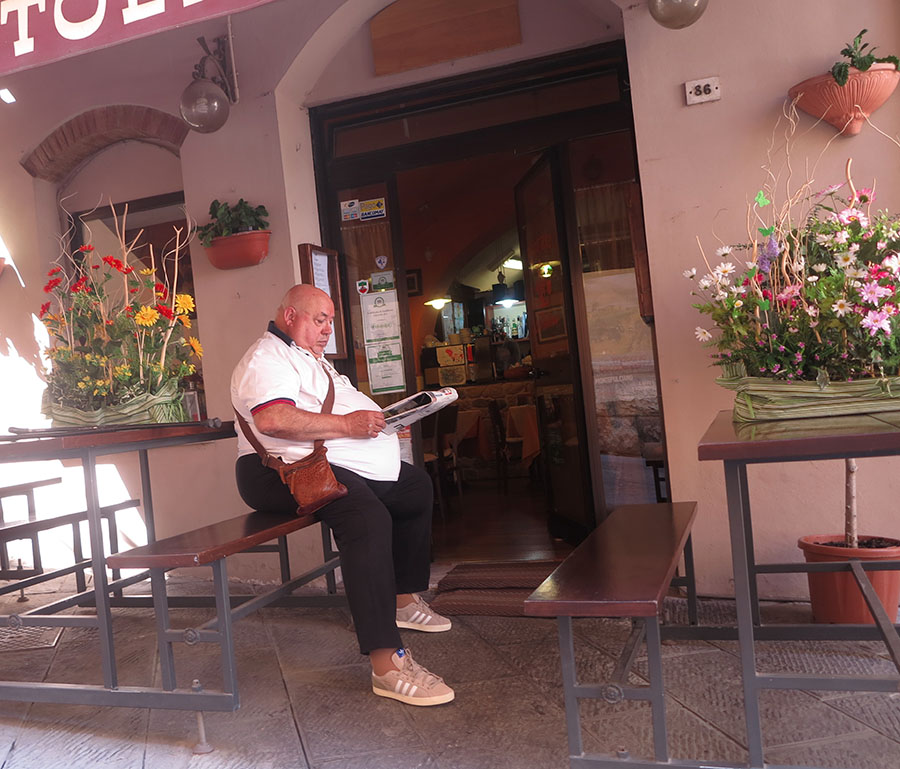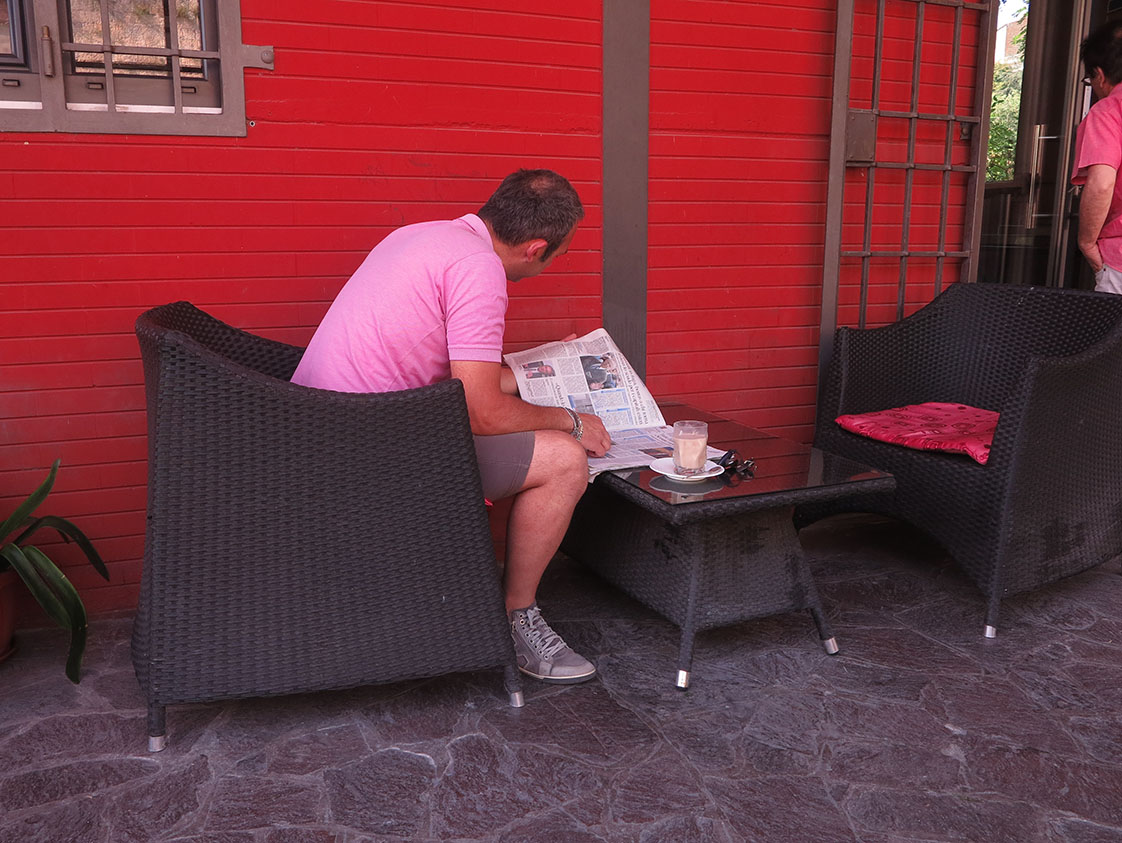
The Roadshow takes a slight diversion this month, a dip into sunny Tuscany where Mr. Joke finds a parable and lesson about the importance of community journalism in the charming 16th century hill town of Montepulciano.
The world traveler with a weather eye to media consumption can’t help but notice how Italians devour their newspapers.
Look, here’s this 30-something sitting beside us at Caffé Stella, Montepulciano’s most popular outdoor bistro. He’s got his cappuccino and his La Nazionale, which is receiving his undivided attention.

And then, when our man is done with his coffee, he gets up and goes inside the café…and within two minutes, the 40-something woman, seated opposite us with her collie dog, reaches over and picks up the La Nazione for herself.
Then, within 10 minutes, a 60-something woman, who appears to know the collie woman, approaches her and asks if she can read the paper. Si, prego! In the space of 30 minutes, the single copy of La Nazione has passed hands three times.
And so it goes.
Inside Café Stella when I ordered my morning caffe, copies of the paper were lying about on empty tables, open to the sports pages where local soccer wars were documented.
Earlier this morning, when we dropped off our son and his daughter at the bus station, a newspaper stand offered no less than a dozen Italian newspapers. Outside, three locals, escaping the early morning sun, already had their papers out.
I am not making this stuff up; newspaper consumption here is prodigious and consistent – and downright encouraging to this old newsroom rat.
But there is something missing. Montepulciano itself has no hometown community newspaper.
To my way of thinking, a place without a paper is not a bad place; but it is an incomplete place. After years of study and observation (this ain’t rocket science, folks) it’s obvious that communities with local media function more effectively than places that are local media deserts.
Take Carrboro, for instance. Since the death of the Carrboro Citizen, (and with all due respect to Mark Schultz and the Chapel Hill News) there has been a precipitous drop-off in the coverage of local governmental and public affairs. For instance, when is the construction going to be finally finished on Smith Level Road leading to Carrboro High School? I have no earthly idea.
If Bubba Dickson’s newspaper were still with us, we would not only know exactly what is going on, we’d be informed of the backstory, the build-out as well as the blow by blow process.
How important is a hometown community newspaper to the successful functioning of a town?

An Italian Local Media Desert
One day last week, without any warning or advance notice, the town’s only grocery abruptly shut down. Townspeople and tourists alike walked past and gaped at a sign outside that read simply, “Store closed.”
What’s happened? Where will we shop? What will we do? What happened to our store? Why did it close? — all these questions and more buzzed from one person to another. This closing affected us all!
The nearest town with a grocery store is 20 minutes away by car or bus, down the mountain and over the valley.
What about all the elderly people of the town who walked daily to this market? What will they do?
How could a thing like this be allowed to happen? Did local government know anything about this in advance?
But because this little town does NOT have a community newspaper of its own, none of these questions could be answered. In short, we did not know what was going on, and long-time residents of this town were just as in the dark — uniformed and ignorant of the facts and the truth as were we tourists!

The just in!
It occurs to me now that I haven’t seen a TV screen in over two weeks. Oh, it’s not that TVs aren’t around. But they just don’t dominate private lives like they do at home.
Additionally, in this ancient village, the self-proclaimed “Pearl of the 16th century,” the mere presence of the tube strikes me as anachronistic, completely out of place and an insult to the present.
But we do have breaking news in Montepulciano.
We have learned why the village’s only downtown supermarket closed last week.
At our favorite outdoor café yesterday, our regular wait staffer, Johnny, told us there had been a late-night electrical fire at the grocery store, and that the staff was working furiously to clean up the smoke damage so the store can re-open as soon as possible.
We are delighted with this news, not so much for ourselves, but for the townies who depend on the supermarket for its walkable easy access and chain store prices.
Additionally, it’s worth noting that for days we tourists went uninformed, and that when we did get the story, it came — neither from a newspaper, nor from TV — or even the town’s local web site (the latter of which had not a peep about the fire) — but from the most basic form of communication: old-fashioned word-of-mouth.
And being an old reporter, I corroborated Johnny’s story with another local we’ve befriended. Yes, the fire was started by an overheated WiFi router in the back of the store.
“Digital in Montepulciano,” Carmella tells us with a wry grin, “is a work-in-progress.”
Back at Caffe Stella, I finish my cappuccino and glance back at the table where the well-worn, much-read copy of La Nazione sits, awaiting its next set of eyes. In the last hour, that single copy has been read by no less than four people.


